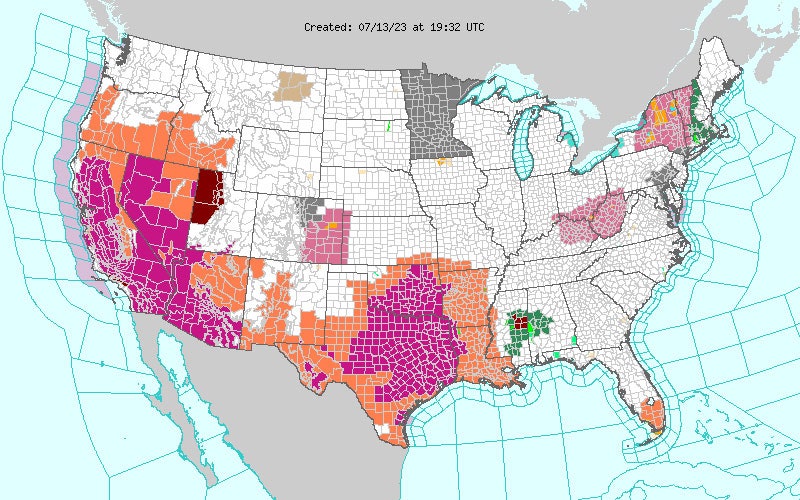Just weeks after a third of the US population was hit with air-quality alerts thanks to smoke from climate-change-fueled fires in Canada, 100 million Americans are now under heat alerts. A cap of extra-hot air, known as a heat dome, has settled over the West and South, pushing temperatures relentlessly higher.
The map below shows excessive heat warnings in purple and heat advisories in orange, and the forecast is that things will get worse through the weekend. Highs will stay above 110 degrees Fahrenheit in Phoenix; California’s Death Valley is flirting with 130 degrees; and Texas’s grid is struggling to keep the AC on.
Illustration: NWS
This follows the hottest June on record globally. “With an evolving El Niño event, that is certain to further increase global temperatures,” says Howard Diamond, climate science program manager at the National Oceanic and Atmospheric Administration’s Air Resources Laboratory. (El Niño is a band of warm water that develops in the Pacific Ocean and influences weather around the world.) “Canada has also experienced multiple bouts of prolonged heat this summer, contributing to the worst wildfire season the country has ever seen,” Diamond adds.
A heat dome is essentially stagnation. It forms as a strong high-pressure system. As that air descends to the ground, it compresses and significantly warms up: A few thousand feet up, air might be 80 degrees, but it can reach 100 degrees once it hits the land.
This descending cap of hot air self-perpetuates for days or even weeks. It discourages the formation of clouds, allowing the sun’s energy to hit the landscape full force, further raising ground temperatures. At the beginning of a heat dome, moisture in the dirt and plants evaporates away, somewhat cooling the landscape—it’s sweating, basically. But as the heat continues for days on end, that moisture runs out and temperatures climb higher.
In other words, the heat dome feeds on itself. “There is no cloud cover, there is a lot of solar radiation coming in, there is no precipitation,” says Claudia Tebaldi, a climate scientist at the Pacific Northwest National Laboratory. “You also trigger this feedback—you dry the soil, and there is no way for things to cool down by evaporation.”
That self-perpetuation makes heat domes extremely dangerous. It’s bad enough when temperatures rise above 110 for a single day, especially for people with conditions like asthma, because the heat leads to the formation of ozone, which irritates the airways. But if temperatures soar for days—and especially if temperatures stay high overnight—the body has no time to recover. The stress keeps piling up.


